Stewart J. Calculus
Подождите немного. Документ загружается.

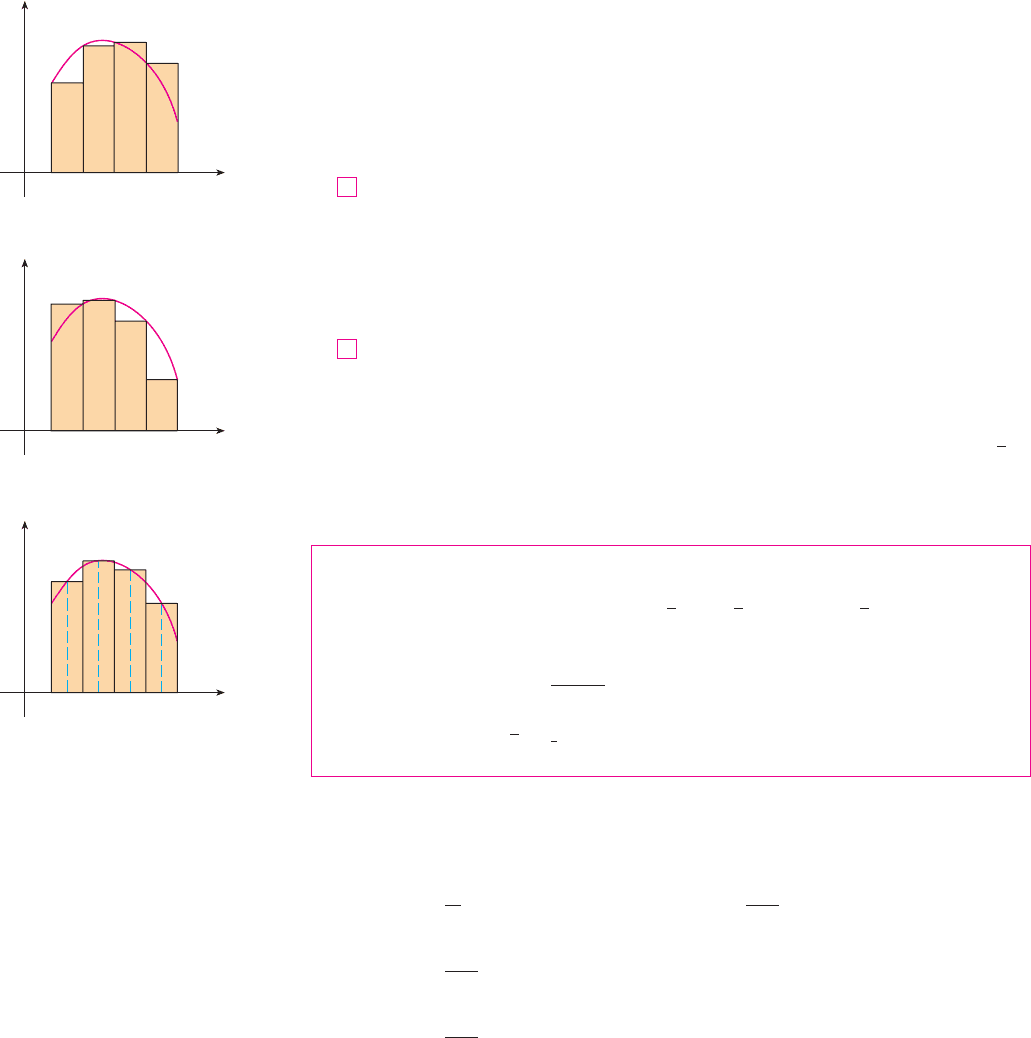
The second situation arises when the function is determined from a scientific experi-
ment through instrument readings or collected data. There may be no formula for the func-
tion (see Example 5).
In both cases we need to find approximate values of definite integrals. We already know
one such method. Recall that the definite integral is defined as a limit of Riemann sums,
so any Riemann sum could be used as an approximation to the integral: If we divide
into subintervals of equal length , then we have
where is any point in the th subinterval . If is chosen to be the left endpoint
of the interval, then and we have
If , then the integral represents an area and (1) represents an approximation of this
area by the rectangles shown in Figure 1(a). If we choose to be the right endpoint, then
and we have
[See Figure 1(b).] The approximations and defined by Equations 1 and 2 are called
the left endpoint approximation and right endpoint approximation, respectively.
In Section 5.2 we also considered the case where is chosen to be the midpoint of
the subinterval . Figure 1(c) shows the midpoint approximation , which appears
to be better than either or .
MIDPOINT RULE
and
Another approximation, called the Trapezoidal Rule, results from averaging the approx-
imations in Equations 1 and 2:
!
'x
2
( f !x
0
" ! 2 f !x
1
" ! 2 f !x
2
" ! ( ( ( ! 2 f !x
n"1
" ! f !x
n
")
!
'x
2
[
(
f !x
0
" ! f !x
1
"
)
!
(
f !x
1
" ! f !x
2
"
)
! ( ( ( !
(
f !x
n"1
" ! f !x
n
"
)
]
y
b
a
f !x" dx *
1
2
&
+
n
i!1
f !x
i"1
" 'x !
+
n
i!1
f !x
i
" 'x
'
!
'x
2
&
+
n
i!1
(
f !x
i"1
" ! f !x
i
"
)
'
x
i
!
1
2
!x
i"1
! x
i
" ! midpoint of (x
i"1
, x
i
)
'x !
b " a
n
where
y
b
a
f !x" dx * M
n
! 'x ( f !x
1
" ! f !x
2
" ! ( ( ( ! f !x
n
")
R
n
L
n
M
n
(x
i"1
, x
i
)
x
i
x
i
*
R
n
L
n
y
b
a
f !x" dx * R
n
!
+
n
i!1
f !x
i
" 'x
2
x
i
*
! x
i
x
i
*
f !x" ) 0
y
b
a
f !x" dx * L
n
!
+
n
i!1
f !x
i"1
" 'x
1
x
i
*
! x
i"1
x
i
*
(x
i"1
, x
i
)ix
i
*
y
b
a
f !x" dx *
+
n
i!1
f !x
i
*
" 'x
'x ! !b " a"%nn
(a, b)
532
|| ||
CHAPTER 8 TECHNIQUES OF INTEGRATION
⁄ ¤
– – ––
(a) Left endpoint approximation
y
x¸ ⁄ ¤ ‹ x¢
x¸ ⁄ ¤ ‹ x¢
‹ x¢
x
0
(b) Right endpoint approximation
y
x
0
x
(c) Midpoint approximation
y
0
F I G U R E 1
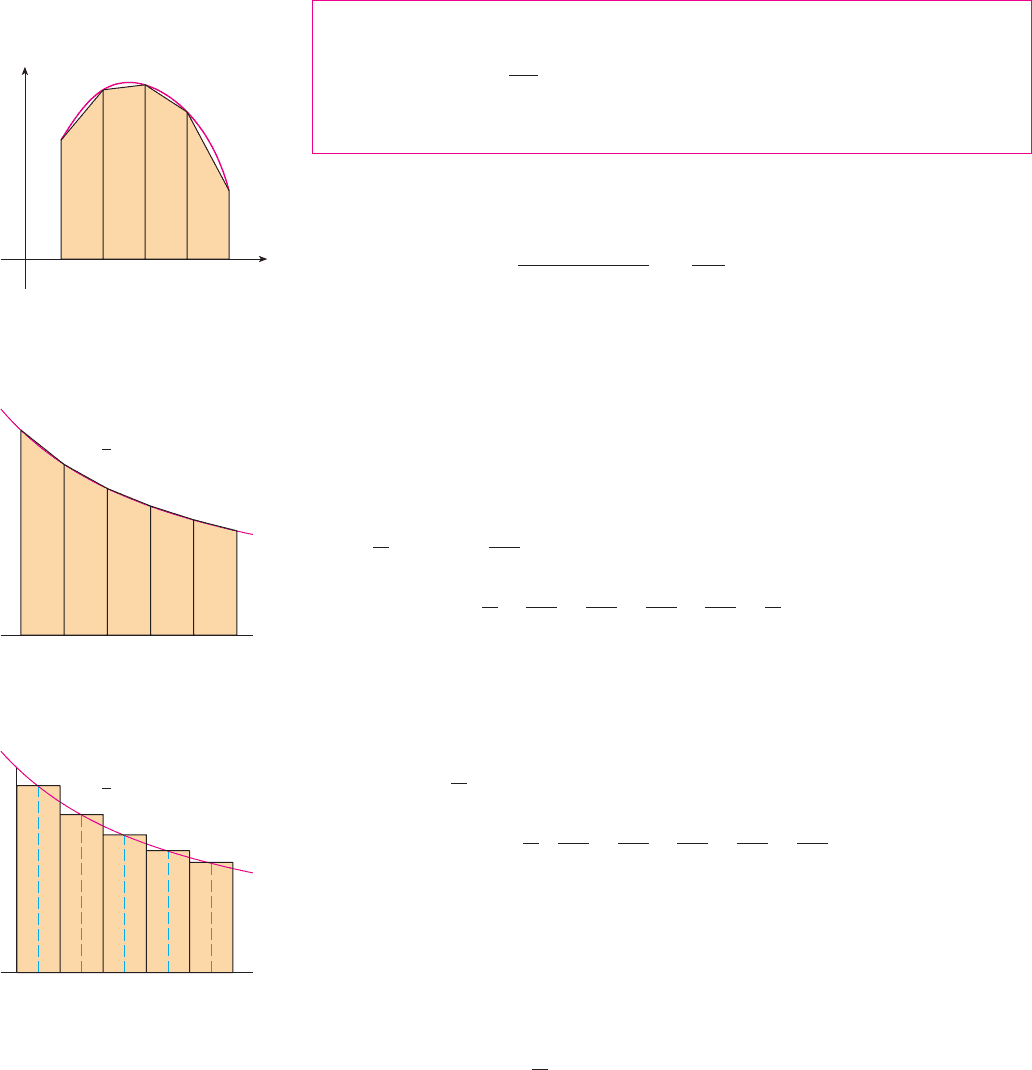
TRAPEZOIDAL RULE
where and .
The reason for the name Trapezoidal Rule can be seen from Figure 2, which illustrates
the case . The area of the trapezoid that lies above the th subinterval is
and if we add the areas of all these trapezoids, we get the right side of the Trapezoidal
Rule.
EXAMPLE 1 Use (a) the Trapezoidal Rule and (b) the Midpoint Rule with to
approximate the integral .
SOLUTION
(a) With , and , we have , and so the Trape-
zoidal Rule gives
This approximation is illustrated in Figure 3.
(b) The midpoints of the five subintervals are , , , , and , so the Midpoint
Rule gives
This approximation is illustrated in Figure 4. M
In Example 1 we deliberately chose an integral whose value can be computed explicitly
so that we can see how accurate the Trapezoidal and Midpoint Rules are. By the Funda-
mental Theorem of Calculus,
The error in using an approximation is defined to be the amount that needs to be added to
the approximation to make it exact. From the values in Example 1 we see that the errors
in the Trapezoidal and Midpoint Rule approximations for are
E
M
* 0.001239
and
E
T
* "0.002488
n ! 5
y
2
1
1
x
dx ! ln x
]
1
2
! ln 2 ! 0.693147 . . .
* 0.691908
!
1
5
#
1
1.1
!
1
1.3
!
1
1.5
!
1
1.7
!
1
1.9
$
y
2
1
1
x
dx * 'x ( f !1.1" ! f !1.3" ! f !1.5" ! f !1.7" ! f !1.9")
1.91.71.51.31.1
* 0.695635
! 0.1
#
1
1
!
2
1.2
!
2
1.4
!
2
1.6
!
2
1.8
!
1
2
$
y
2
1
1
x
dx * T
5
!
0.2
2
( f !1" ! 2 f !1.2" ! 2 f !1.4" ! 2 f !1.6" ! 2 f !1.8" ! f !2")
'x ! !2 " 1"%5 ! 0.2b ! 2n ! 5, a ! 1
x
2
1
!1%x" dx
n ! 5
'x
#
f !x
i"1
" ! f !x
i
"
2
$
!
'x
2
( f !x
i"1
" ! f !x
i
")
if !x" ) 0
x
i
! a ! i 'x'x ! !b " a"%n
y
b
a
f !x" dx * T
n
!
'x
2
( f !x
0
" ! 2 f !x
1
" ! 2 f !x
2
" ! ( ( ( ! 2 f !x
n"1
" ! f !x
n
")
SECTION 8.7 APPROXIMATE INTEGRATION
|| ||
533
F I G U R E 3
0
y
x
x¸ ⁄ ¤ ‹ x¢
F I G U R E 2
Trapezoidal approximation
F I G U R E 4
1 2
1 2
1
x
y=
1
x
y=
y
b
a
f !x" dx ! approximation ! error

In general, we have
The following tables show the results of calculations similar to those in Example 1, but
for , and and for the left and right endpoint approximations as well as the
Trapezoidal and Midpoint Rules.
We can make several observations from these tables:
1. In all of the methods we get more accurate approximations when we increase the
value of . (But very large values of result in so many arithmetic operations that
we have to beware of accumulated round-off error.)
2. The errors in the left and right endpoint approximations are opposite in sign and
appear to decrease by a factor of about 2 when we double the value of .
3. The Trapezoidal and Midpoint Rules are much more accurate than the endpoint
approximations.
4. The errors in the Trapezoidal and Midpoint Rules are opposite in sign and appear
to decrease by a factor of about 4 when we double the value of .
5. The size of the error in the Midpoint Rule is about half the size of the error in the
Trapezoidal Rule.
Figure 5 shows why we can usually expect the Midpoint Rule to be more accurate than
the Trapezoidal Rule. The area of a typical rectangle in the Midpoint Rule is the same as
the area of the trapezoid whose upper side is tangent to the graph at . The area of
this trapezoid is closer to the area under the graph than is the area of the trapezoid
used in the Trapezoidal Rule. [The midpoint error (shaded red) is smaller than the trape-
zoidal error (shaded blue).]
F I G U R E 5
C
P
D
A
B
R
Q
C
P
D
A
B
x
i-1
x
ii-1
x
–
i
AQRD
PABCD
n
n
nn
20n ! 5, 10
E
M
!
y
b
a
f !x" dx " M
n
andE
T
!
y
b
a
f !x" dx " T
n
534
|| ||
CHAPTER 8 TECHNIQUES OF INTEGRATION
n
5 0.745635 0.645635 0.695635 0.691908
10 0.718771 0.668771 0.693771 0.692835
20 0.705803 0.680803 0.693303 0.693069
M
n
T
n
R
n
L
n
n
5 "0.052488 0.047512 "0.002488 0.001239
10 "0.025624 0.024376 "0.000624 0.000312
20 "0.012656 0.012344 "0.000156 0.000078
E
M
E
T
E
R
E
L
Approximations to
y
2
1
1
x
dx
Corresponding errors
N It turns out that these observations are true
in most cases.
Module 5.2 /8.7 allows you to
compare approximation methods.
TE C

These observations are corroborated in the following error estimates, which are proved
in books on numerical analysis. Notice that Observation 4 corresponds to the in each
denominator because . The fact that the estimates depend on the size of the
second derivative is not surprising if you look at Figure 5, because measures how
much the graph is curved. [Recall that measures how fast the slope of
changes.]
ERROR BOUNDS Suppose for . If and are the
errors in the Trapezoidal and Midpoint Rules, then
Let’s apply this error estimate to the Trapezoidal Rule approximation in Example 1. If
, then and . Since , we have , so
Therefore, taking , and in the error estimate (3), we see that
Comparing this error estimate of with the actual error of about , we see
that it can happen that the actual error is substantially less than the upper bound for the
error given by (3).
EXAMPLE 2 How large should we take in order to guarantee that the Trapezoidal
and Midpoint Rule approximations for are accurate to within ?
SOLUTION We saw in the preceding calculation that for , so we can
take , , and in (3). Accuracy to within means that the size of
the error should be less than . Therefore we choose so that
Solving the inequality for , we get
or
Thus will ensure the desired accuracy.n ! 41
n *
1
s
0.0006
* 40.8
n
2
*
2
12!0.0001"
n
2!1"
3
12n
2
+
0.0001
n0.0001
0.0001b ! 2a ! 1K ! 2
1 % x % 2
,
f ,!x"
,
% 2
0.0001
x
2
1
!1%x" dx
n
V
0.0024880.006667
,
E
T
,
%
2!2 " 1"
3
12!5"
2
!
1
150
* 0.006667
n ! 5K ! 2, a ! 1, b ! 2
,
f ,!x"
,
!
-
2
x
3
-
%
2
1
3
! 2
1%x % 11 % x % 2f ,!x" ! 2%x
3
f -!x" ! "1%x
2
f !x" ! 1%x
,
E
M
,
%
K!b " a"
3
24n
2
and
,
E
T
,
%
K!b " a"
3
12n
2
E
M
E
T
a % x % b
,
f ,!x"
,
% K
3
y ! f !x"f ,!x"
f ,!x"
!2n"
2
! 4n
2
n
2
SECTION 8.7 APPROXIMATE INTEGRATION
|| ||
535
N It’s quite possible that a lower value for
would suffice, but is the smallest value for
which the error bound formula can
guarantee
us
accuracy to within .0.0001
41
n
N can be any number larger than all the
values of , but smaller values of
give better error bounds.
K
,
f ,!x"
,
K
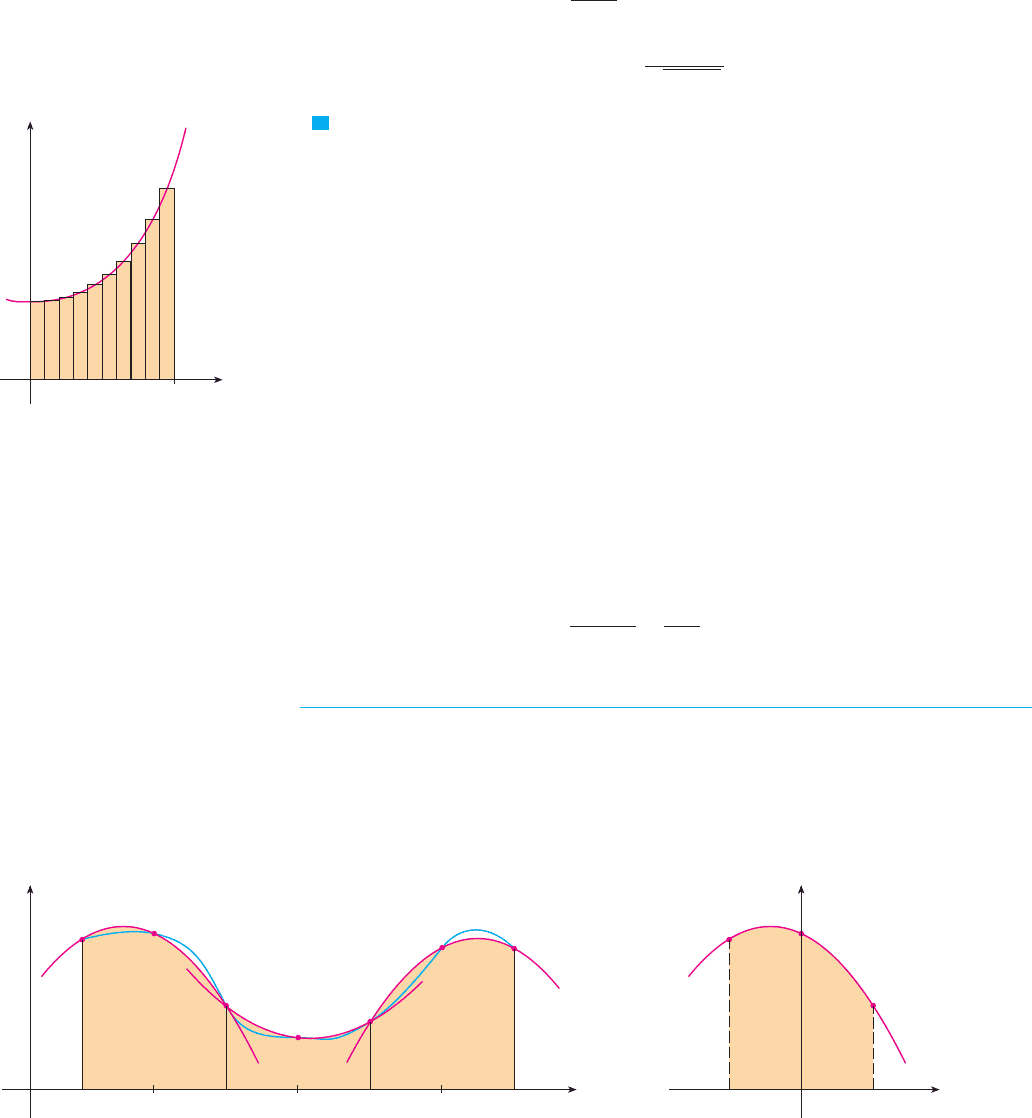
For the same accuracy with the Midpoint Rule we choose so that
which gives
M
EXAMPLE 3
(a) Use the Midpoint Rule with to approximate the integral .
(b) Give an upper bound for the error involved in this approximation.
SOLUTION
(a) Since , and , the Midpoint Rule gives
Figure 6 illustrates this approximation.
(b) Since , we have and . Also, since
, we have and so
Taking , , , and in the error estimate (3), we see that an upper
bound for the error is
M
SIMPSON’S RULE
Another rule for approximate integration results from using parabolas instead of straight
line segments to approximate a curve. As before, we divide into subintervals of
equal length , but this time we assume that is an even number. Then
on each consecutive pair of intervals we approximate the curve by a parabola
as shown in Figure 7. If , then is the point on the curve lying above .
A typical parabola passes through three consecutive points , and .
0
y
x
a=x¸ ⁄ x™ x¢x£ xß=bx∞
P¸
P¡
P™
P¢
P£
Pß
P∞
F I G U R E 7
0
y
x
h_h
P¸(_h,y¸)
P¡(0,› )
P™(h,fi)
F I G U R E 8
P
i!2
P
i
, P
i!1
x
i
P
i
!x
i
, y
i
"y
i
! f !x
i
"
y ! f !x" ) 0
nh ! 'x ! !b " a"%n
n(a, b)
6e!1"
3
24!10"
2
!
e
400
* 0.007
n ! 10b ! 1a ! 0K ! 6e
0 % f ,!x" ! !2 ! 4x
2
"e
x
2
% 6e
x
2
% 10 % x % 1
f ,!x" ! !2 ! 4x
2
"e
x
2
f -!x" ! 2xe
x
2
f !x" ! e
x
2
* 1.460393
! e
0.4225
! e
0.5625
! e
0.7225
! e
0.9025
)
! 0.1(e
0.0025
! e
0.0225
! e
0.0625
! e
0.1225
! e
0.2025
! e
0.3025
y
1
0
e
x
2
dx * 'x ( f !0.05" ! f !0.15" ! ( ( ( ! f !0.85" ! f !0.95")
n ! 10a ! 0, b ! 1
x
1
0
e
x
2
dxn ! 10
V
n *
1
s
0.0012
* 29
2!1"
3
24n
2
+
0.0001
n
536
|| ||
CHAPTER 8 TECHNIQUES OF INTEGRATION
0
y
x
1
F I G U R E 6
y=e
x
2
N Error estimates give upper bounds for
the error. They are theoretical, worst-case
scenarios. The actual error in this case turns
out to be about .0.0023

To simplify our calculations, we first consider the case where , and
. (See Figure 8.) We know that the equation of the parabola through , and
is of the form and so the area under the parabola from to
is
But, since the parabola passes through , , and , we have
and therefore
Thus we can rewrite the area under the parabola as
Now, by shifting this parabola horizontally we do not change the area under it. This means
that the area under the parabola through , and from to in Figure 7
is still
Similarly, the area under the parabola through from to is
If we compute the areas under all the parabolas in this manner and add the results, we get
Although we have derived this approximation for the case in which , it is a rea-
sonable approximation for any continuous function and is called Simpson’s Rule after
the English mathematician Thomas Simpson (1710–1761). Note the pattern of coeffi-
cients: .1, 4, 2, 4, 2, 4, 2, . . . , 4, 2, 4, 1
f
f !x" ) 0
!
h
3
!y
0
! 4y
1
! 2y
2
! 4y
3
! 2y
4
! ( ( ( ! 2y
n"2
! 4y
n"1
! y
n
"
! ( ( ( !
h
3
!y
n"2
! 4y
n"1
! y
n
"
y
b
a
f !x" dx *
h
3
!y
0
! 4y
1
! y
2
" !
h
3
!y
2
! 4y
3
! y
4
"
h
3
!y
2
! 4y
3
! y
4
"
x ! x
4
x ! x
2
P
2
, P
3
, and P
4
h
3
!y
0
! 4y
1
! y
2
"
x ! x
2
x ! x
0
P
2
P
0
, P
1
h
3
!y
0
! 4y
1
! y
2
"
y
0
! 4y
1
! y
2
! 2Ah
2
! 6C
y
2
! Ah
2
! Bh ! C
y
1
! C
y
0
! A!"h"
2
! B!"h" ! C ! Ah
2
" Bh ! C
P
2
!h, y
2
"P
1
!0, y
1
"P
0
!"h, y
0
"
! 2
#
A
h
3
3
! Ch
$
!
h
3
!2Ah
2
! 6C"
! 2
&
A
x
3
3
! Cx
'
0
h
y
h
"h
!Ax
2
! Bx ! C" dx ! 2
y
h
0
!Ax
2
! C" dx
x ! h
x ! "hy ! Ax
2
! Bx ! C
P
2
P
0
, P
1
x
2
! h
x
0
! "h, x
1
! 0
SECTION 8.7 APPROXIMATE INTEGRATION
|| ||
537
N Here we have used Theorem 5.5.6.
Notice that is even and is odd.BxAx
2
! C

SIMPSON’S RULE
where is even and .
EXAMPLE 4 Use Simpson’s Rule with to approximate .
SOLUTION Putting , and in Simpson’s Rule, we obtain
M
Notice that, in Example 4, Simpson’s Rule gives us a much better approximation
to the true value of the integral than does the
Trapezoidal Rule or the Midpoint Rule . It turns out
(see Exercise 48) that the approximations in Simpson’s Rule are weighted averages of
those in the Trapezoidal and Midpoint Rules:
(
Recall that and usually have opposite signs and is about half the size of .
)
In many applications of calculus we need to evaluate an integral even if no explicit for-
mula is known for y as a function of x. A function may be given graphically or as a table
of values of collected data. If there is evidence that the values are not changing rapidly,
then the Trapezoidal Rule or Simpson’s Rule can still be used to find an approximate value
for , the integral of y with respect to x.
EXAMPLE 5 Figure 9 shows data traffic on the link from the United States to SWITCH,
the Swiss academic and research network, on February 10, 1998. is the data through-
put, measured in megabits per second . Use Simpson’s Rule to estimate the total
amount of data transmitted on the link up to noon on that day.
F I G U R E 9
0
2
4
6
D
8
3 6 9 12 15 18 21 24
t (hours)
!Mb"s#
D!t#
V
x
b
a
y dx
$
E
T
$$
E
M
$
E
M
E
T
S
2n
!
1
3
T
n
!
2
3
M
n
!M
10
% 0.692835#!T
10
% 0.693771#
!ln 2 % 0.693147. . .#!S
10
% 0.693150#
% 0.693150
!
0.1
3
&
1
1
!
4
1.1
!
2
1.2
!
4
1.3
!
2
1.4
!
4
1.5
!
2
1.6
!
4
1.7
!
2
1.8
!
4
1.9
!
1
2
'
!
"x
3
( f !1# ! 4 f !1.1# ! 2 f !1.2# ! 4 f !1.3# ! # # # ! 2 f !1.8# ! 4 f !1.9# ! f !2#)
y
2
1
1
x
dx % S
10
"x ! 0.1f !x# ! 1"x, n ! 10
x
2
1
!1"x# dxn ! 10
"x ! !b $ a#"nn
! 2 f !x
n$2
# ! 4 f !x
n$1
# ! f !x
n
#)
y
b
a
f !x# dx % S
n
!
"x
3
( f !x
0
# ! 4 f !x
1
# ! 2 f !x
2
# ! 4 f !x
3
# ! # # #
538
|| ||
CHAPTER 8 TECHNIQUES OF INTEGRATION
Thomas Simpson was a weaver who taught
himself mathematics and went on to become one
of the best English mathematicians of the 18th
century. What we call Simpson’s Rule was
actually known to Cavalieri and Gregory in the
17th century, but Simpson popularized it in his
best-selling calculus textbook,
A New Treatise
of Fluxions.
SI M PS O N

SOLUTION Because we want the units to be consistent and is measured in megabits
per second, we convert the units for from hours to seconds. If we let be the
amount of data (in megabits) transmitted by time , where is measured in seconds, then
. So, by the Net Change Theorem (see Section 5.4), the total amount of data
transmitted by noon (when ) is
We estimate the values of at hourly intervals from the graph and compile them in
the table.
Then we use Simpson’s Rule with and to estimate the integral:
Thus the total amount of data transmitted up to noon is about 144,000 megabits, or
144 gigabits. M
The table in the margin shows how Simpson’s Rule compares with the Midpoint Rule
for the integral , whose true value is about 0.69314718. The second table shows
how the error in Simpson’s Rule decreases by a factor of about 16 when is doubled.
(In Exercises 27 and 28 you are asked to verify this for two additional integrals.) That is
consistent with the appearance of in the denominator of the following error estimate for
Simpson’s Rule. It is similar to the estimates given in (3) for the Trapezoidal and Midpoint
Rules, but it uses the fourth derivative of .
ERROR BOUND FOR SIMPSON’S RULE Suppose that for
. If is the error involved in using Simpson’s Rule, then
$
E
S
$
%
K!b $ a#
5
180n
4
E
S
a % x % b
$
f
!4#
!x#
$
% K
4
f
n
4
nE
s
x
2
1
!1"x# dx
! 143,880
! 2!1.1# ! 4!1.3# ! 2!2.8# ! 4!5.7# ! 2!7.1# ! 4!7.7# ! 7.9)
%
3600
3
(3.2 ! 4!2.7# ! 2!1.9# ! 4!1.7# ! 2!1.3# ! 4!1.0#
y
43,200
0
A!t# dt %
"t
3
(D!0# ! 4D!3600# ! 2D!7200# ! # # # ! 4D!39,600# ! D!43,200#)
"t ! 3600n ! 12
D!t#
A!43,200# !
y
43,200
0
D!t# dt
t ! 12 & 60
2
! 43,200
A'!t# ! D!t#
tt
A!t#t
D!t#
SECTION 8.7 APPROXIMATE INTEGRATION
|| ||
539
0 0 3.2 7 25,200 1.3
1 3,600 2.7 8 28,800 2.8
2 7,200 1.9 9 32,400 5.7
3 10,800 1.7 10 36,000 7.1
4 14,400 1.3 11 39,600 7.7
5 18,000 1.0 12 43,200 7.9
6 21,600 1.1
D!t#t !seconds#t !hours#D!t#t !seconds#t !hours#
4 0.69121989 0.69315453
8 0.69266055 0.69314765
16 0.69302521 0.69314721
S
n
M
n
n
4 0.00192729
8 0.00048663
16 0.00012197 $0.00000003
$0.00000047
$0.00000735
E
S
E
M
n
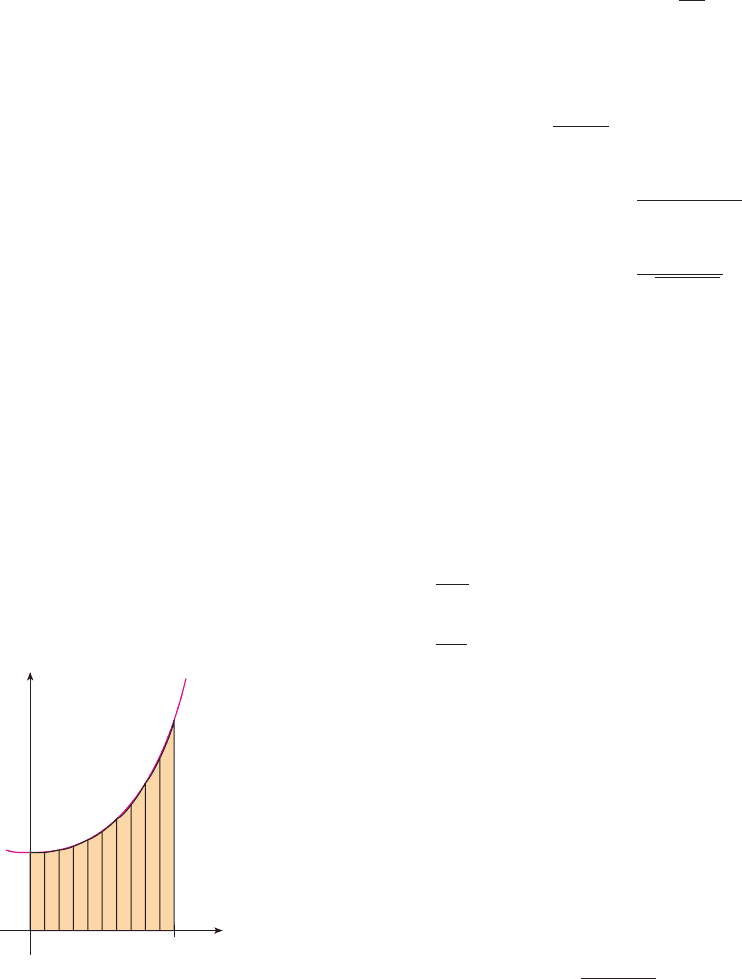
EXAMPLE 6 How large should we take in order to guarantee that the Simpson’s Rule
approximation for is accurate to within ?
SOLUTION If , then . Since , we have and so
Therefore we can take in (4). Thus, for an error less than , we should
choose so that
This gives
or
Therefore ( must be even) gives the desired accuracy. (Compare this with
Example 2, where we obtained for the Trapezoidal Rule and for the
Midpoint Rule.)
M
EXAMPLE 7
(a) Use Simpson’s Rule with to approximate the integral .
(b) Estimate the error involved in this approximation.
SOLUTION
(a) If , then and Simpson’s Rule gives
(b) The fourth derivative of is
and so, since , we have
Therefore, putting , and in (4), we see that the error is at
most
(Compare this with Example 3.) Thus, correct to three decimal places, we have
M
y
1
0
e
x
2
dx % 1.463
76e!1#
5
180!10#
4
% 0.000115
n ! 10K ! 76e, a ! 0, b ! 1
0 % f
!4#
!x# % !12 ! 48 ! 16#e
1
! 76e
0 % x % 1
f
!4#
!x# ! !12 ! 48x
2
! 16x
4
#e
x
2
f !x# ! e
x
2
% 1.462681
! 4e
0.49
! 2e
0.64
! 4e
0.81
! e
1
)
!
0.1
3
(e
0
! 4e
0.01
! 2e
0.04
! 4e
0.09
! 2e
0.16
! 4e
0.25
! 2e
0.36
y
1
0
e
x
2
dx %
"x
3
( f !0# ! 4 f !0.1# ! 2 f !0.2# ! # # # ! 2 f !0.8# ! 4 f !0.9# ! f !1#)
"x ! 0.1n ! 10
x
1
0
e
x
2
dxn ! 10
n ! 29n ! 41
nn ! 8
n (
1
s
4
0.00075
% 6.04
n
4
(
24
180!0.0001#
24!1#
5
180n
4
)
0.0001
n
0.0001K ! 24
$
f
!4#
!x#
$
!
*
24
x
5
*
% 24
1"x % 1x * 1f
!4#
!x# ! 24"x
5
f !x# ! 1"x
0.0001x
2
1
!1"x# dx
n
540
|| ||
CHAPTER 8 TECHNIQUES OF INTEGRATION
N Many calculators and computer algebra sys-
tems have a built-in algorithm that computes an
approximation of a definite integral. Some of
these machines use Simpson’s Rule; others use
more sophisticated techniques such as
adaptive
numerical integration. This means that if a func-
tion fluctuates much more on a certain part of
the interval than it does elsewhere, then that
part gets divided into more subintervals. This
strategy reduces the number of calculations
required to achieve a prescribed accuracy.
N Figure 10 illustrates the calculation in
Example 7. Notice that the parabolic arcs are
so close to the graph of that they are
practically indistinguishable from it.
y ! e
x
2
0
y
x
1
y=e
x
2
F I G U R E 1 0
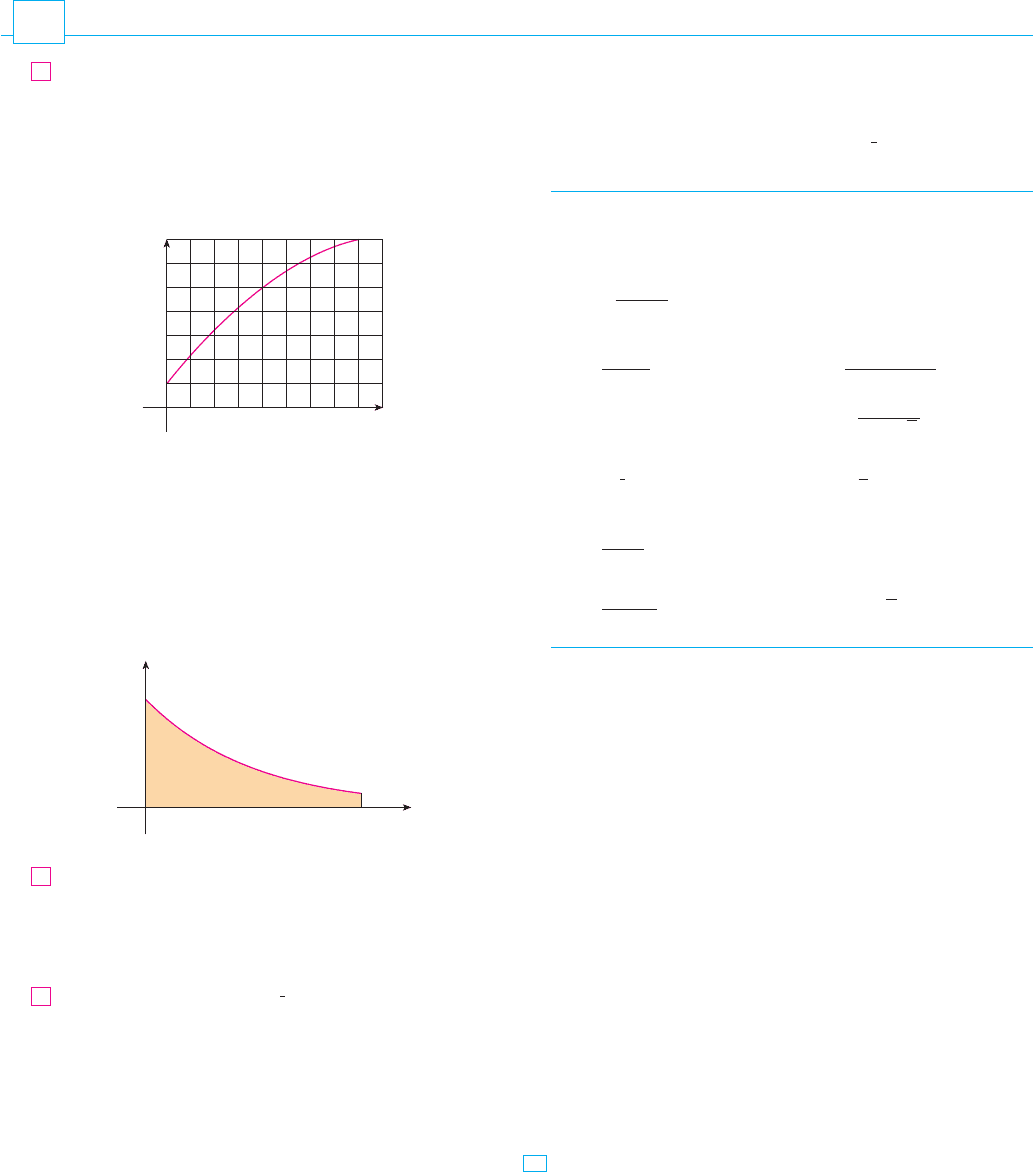
SECTION 8.7 APPROXIMATE INTEGRATION
|| ||
541
(Round your answers to six decimal places.) Compare your
results to the actual value to determine the error in each
approximation.
5. , 6. ,
7–18 Use (a) the Trapezoidal Rule, (b) the Midpoint Rule, and
(c) Simpson’s Rule to approximate the given integral with the
specified value of . (Round your answers to six decimal places.)
7.
,
8. ,
9.
,
10. ,
11. , 12. ,
13.
,
14. ,
15. , 16. ,
17. , 18. ,
19. (a) Find the approximations and for the integral
.
(b) Estimate the errors in the approximations of part (a).
(c) How large do we have to choose so that the approxima-
tions and to the integral in part (a) are accurate to
within ?
20. (a) Find the approximations and for .
(b) Estimate the errors in the approximations of part (a).
(c) How large do we have to choose so that the approxima-
tions and to the integral in part (a) are accurate to
within ?
21. (a) Find the approximations , , and for
and the corresponding errors , , and .
(b) Compare the actual errors in part (a) with the error esti-
mates given by (3) and (4).
(c) How large do we have to choose so that the approxima-
tions , , and to the integral in part (a) are accurate
to within ?
22. How large should be to guarantee that the Simpson’s Rule
approximation to is accurate to within ?
23. The trouble with the error estimates is that it is often very
difficult to compute four derivatives and obtain a good upper
bound for by hand. But computer algebra systems
$
f
!4#
!x#
$
K
CAS
0.00001x
1
0
e
x
2
dx
n
0.00001
S
n
M
n
T
n
n
E
S
E
M
E
T
x
+
0
sin x dxS
10
M
10
T
10
0.0001
M
n
T
n
n
x
2
1
e
1"x
dxM
10
T
10
0.0001
M
n
T
n
n
x
1
0
cos !x
2
# dx
M
8
T
8
n ! 10
y
4
0
cos
s
x dxn ! 6
y
3
0
1
1 ! y
5
dy
n ! 10
y
6
4
ln!x
3
! 2# dxn ! 8
y
5
1
cos x
x
dx
n ! 10
y
1
0
s
z
e
$z
dzn ! 8
y
4
0
e
s
t
sin t dt
n ! 8
y
4
0
s
1 !
s
x
dxn ! 8
y
1"2
0
sin!e
t"2
# dt
n ! 6
y
3
0
dt
1 ! t
2
! t
4
n ! 10
y
2
1
ln x
1 ! x
dx
n ! 4
y
1"2
0
sin!x
2
# dxn ! 8
y
2
0
s
4
1 ! x
2
dx
n
n ! 6
y
1
0
e
$
s
x
dxn ! 8
y
+
0
x
2
sin x dx
Let , where is the function whose graph is
shown.
(a) Use the graph to find .
(b) Are these underestimates or overestimates of ?
(c) Use the graph to find . How does it compare with ?
(d) For any value of , list the numbers and
in increasing order.
2. The left, right, Trapezoidal, and Midpoint Rule approxi-
mations were used to estimate , where is the
function whose graph is shown. The estimates were 0.7811,
0.8675, 0.8632, and 0.9540, and the same number of sub-
intervals were used in each case.
(a) Which rule produced which estimate?
(b) Between which two approximations does the true value of
lie?
;
Estimate using (a) the Trapezoidal Rule and
(b) the Midpoint Rule, each with . From a graph of the
integrand, decide whether your answers are underestimates or
overestimates. What can you conclude about the true value of
the integral?
;
Draw the graph of in the viewing rectangle
by and let .
(a) Use the graph to decide whether , and under-
estimate or overestimate .
(b) For any value of , list the numbers and
in increasing order.
(c) Compute . From the graph, which do
you think gives the best estimate of ?
5–6 Use (a) the Midpoint Rule and (b) Simpson’s Rule to
approximate the given integral with the specified value of . n
I
L
5
, R
5
, M
5
, and T
5
I
L
n
, R
n
, M
n
, T
n
,n
I
T
2
L
2
, R
2
, M
2
I ! x
1
0
f !x# dx(0, 0.5)(0, 1)
f !x# ! sin
(
1
2
x
2
)
4.
n ! 4
x
1
0
cos!x
2
#
dx
3.
y
x
0
1
2
y=ƒ
x
2
0
f !x# dx
f
x
2
0
f !x# dx
f
x
1
y
2
3
1
0
2 3 4
IL
n
, R
n
, M
n
, T
n
,n
IT
2
I
L
2
, R
2
, and M
2
fI ! x
4
0
f !x# dx
1.
E X E R C I S E S
8.7
